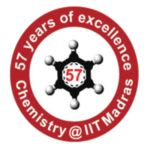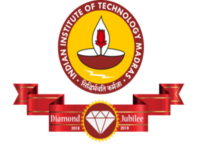- Home
- Research
1. Theoretical rotational- vibrational spectroscopy of excited molecular states:
An extensive study of various types of strong rotational-vibrational coupling terms and their significance as revealed in the spectra of semi-rigid and non-rigid molecules and molecular complexes is a project under investigation by me and my group. In the case of semi-rigid molecules, Coriolis coupling terms dominate over centrifugal coupling terms for low lying vibrationally excited states. The opposite is expected to be true for non-rigid molecules whose vibrational motion has large amplitudes and low frequencies making the separation between rotational and vibrational degrees of freedom fuzzier.
Ph.D. Scholars involved: Mr. Vinayak
1.1 Theoretical rotational-vibrational-torsional spectroscopy for the study of molecular complexes:
Rovibrational spectra of nonrigid molecules and molecular complexes are generally less congested than those of semirigid molecules because of the absence of rotational states with large J values and not many bound vibrational states. However theoretical assignment is very difficult because current experimental set up does not allow very high resolution of neighboring frequencies and because rotation and vibration are much more mixed in these molecules due to large amplitude, low frequency motion. Often these molecules have a torsional degree of freedom with low barrier between different states and coupled to overall rotational states. Theoretical interpretation of the spectra and deducing the details of internal motion / torsional barriers are thus serious challenges for theoretical spectroscopists.
My research interests in this area were initiated by experimental spectra recorded in the laboratory of Professor E. Arunan, Department of Inorganic and Physical Chemistry, IISc, Bangalore. Through mutual collaboration we have worked out effective Hamiltonians for a model system of benzene –water dimer and the analysis of spectra in the presence of static electric filed is currently being carried out. The findings so far have been published in the Journal of Molecular Spectroscopy as a research article.
Ph.D. Scholars involved: Dr. Ram Prasad Bora (completed his Ph. D) and Mr. Vinayak (current)
1.2 Theoretical Calculations of Intensities of Ro-vibrational Spectra of Semi-rigid Molecules
Calculations of intensities of high-resolution, rotational-vibrational spectra have been proposed using a new theoretical method. The dipole moment and polarizabilities are studied in a representation in which the Hamiltonian contains most of the coupling between rotation and vibration through analytic transformation techniques. This theory leads to a new definition for the effective molecular dipole moment of a molecule, which contains rotationally induced contributions. This is a new theory and is aimed at spectroscopisis who use standard, normal-mode expansion of the dipole moment operator for the calculating intensities of high resolution spectra. The results have been published in the Journal of Chemical Physics in part 1 with a second manuscript to be submitted for publication (a preprint is enclosed). The scholar has been awarded the Ph. D. degree (Reports by examiners enclosed) This is a collaborative effort with Professor Tucker Carrington, Univerite de Montreal, Montreal Canada.
Ph. D. scholars involved: Mr. S. Karthikeyan
1.3 Theoretical Calculations of Rotation- and Vibration-dependent Polarizabilities of Semi-rigid Molecules
The calculation of rotational and vibrational dependent polarizabilities for polyatomic molecules is proposed. Diatomic molecular polarizabilities have been studied extensively by David Bishop and coworkers. There are very little theoretical studies on polarizabilities of polyatomic molecules and good quality experimental data are not available as yet. Current research activity by our group is directed to quantitatively deducing the contributions of various rotational and vibrational degrees of freedom and coupling between them to polarizability and first and second order hyper- polarizability. This is a collaborative effort with Professor Tucker Carrington Jr., Univerite de Montreal, Montreal Canada.
Students involved: S. Karthikeyan, Ph.D. and Kshama Roy, M. Sc.
2. Theoretical (Computational) NMR spectroscopy of solid state
Our research interests are theoretical calculations of pulse and time evolution using the spin density operator method in the NMR of solid state using magic angle spinning technique. Van Vleck’s contact transformation method, which is widely used in molecular Spectroscopy has been proposed for study of time-dependent interactions in solid state nuclear magnetic resonance (NMR) by Floquet theory. A considerable amount of work has been done on spin dynamics of magic angle spinning (MAS) NMR experiments using average Hamiltonian theory and Floquet theory. The contact transformation method is an operator method in time-independent perturbation theory and has been used to obtain effective Hamiltonians in molecular spectroscopy. Here the above method is combined with Floquet theory to study the dynamics of a dipolar coupled spin (l =1/2) system. In order to determine the frequencies and intensities of bands in MAS spectra, we need to diagonalize the Floquet-Hamiltonian matrix. This is generally done numerically, by truncating the infinite dimensional Floquet-Hamiltonian matrix. This project has proposed an effective Floquet-Hamiltonian for the system and demonstrated its application to homo-nuclear dipolar coupled two and three spin systems (l =1/2). This research has been carried out by Dr. Ramesh Ramachandran, a research scholar from our group, who is currently a post doctoral research associate in Francis Bitter National Magnet Laboratory in Massachusetts Institute of Technology, Cambridge, Massachusetts, U.S.A. It is currently being extended to propose effective Hamiltonians for rotational echo double resonance pulse sequences in NMR. A preliminary summary has been given by R. Devanathan in his M. Sc Dissertation (May 2003).
Current Ph. D. Scholar: Mr. Manoj Pandey
3.Quantum information processing: Quantum teleportation using density matrix approach and correlations among spins
Quantum information processing: Quantum teleportation using density matrix approach and correlations among spins The density operator for pairs of coupled spins containing correlations among the spins has been used to study the quantum mechanical teleportation process. Experiments have been carried out using the Einstein-Podolsky-Rosen states of two coupled spins (correlated photons) to verify the theoretical scheme first proposed by Charles Bennett, IBM Research laboratory and coworkers. My research in this area involves the use of correlated density matrix of two spins as starting point and analyzing the teleportation process for two, three and multiparticle initial states whose state information may be transferred from one location to another without physical transfer of the states.
Current Ph.D Scholar: Mr. Atul Kumar
4. Ab initio computational chemical methods
4.1 Computational studies on Study of Energetic Molecules using Isodesmic and Homodesmotic methods.
Solid propellants used in rocket propulsion work on the principle of conversion of chemical energy stored in propellant molecules to mechanical energy in the form of thrust. A variety of new and exciting combinations of molecules have been found to be potential candidates for use as propellants in space industry but very little information on their thermodynamic properties such as heats of formation is known. Much of it also remains classified. Therefore, ab initio studies on a few selected molecules that are potentially useful as fuels due to large amount of strain energy in their structurehave been recently initiated. Quantum mechanical calculations using Gaussian 03 and density functional theory and in conjunction with the molecular visualizer Cerius2 are currently being carried out for a class of nitrogen-rich compounds. Some of the nitrogen-rich compounds are quite large and contain many more atoms for which accurate ab initio results using Gaussian 03 are quite difficult to obtain. Several alternatives are being tried including Becke-Yang-Parr functional in the density functional approach and semi-empirical methods. One of the methods successfully studied in our group is the isodesmic method for computing heats of formation of new chemical compounds using both computational and experimental data. Most importantly, isodesmic reactions are so chosen as to very nearly preserve the chemical environment of species on either side of a fictitious reaction.
4.2 Computational studies on cyclic [n]paraphenyleneacetylenes using homodesmotic reactions
5 Cyclic [n]paraphenyleneacetylenes ([n]CPPAs) are potentially useful compounds for molecular electronics. Homodesmotic reaction scheme coupled with density functional theory is being used to estimate theoretically strain energies and heats of formation of [n]CPPAs. Calculations have been done for a series of [n]CPPAs, containing up to ten phenylacetylene units. Strain energies of [n]CPPAs decrease, while heats of formation increase steadily with increase in the number of phenylacetylene units using homodesmotic reaction 10 schemes. B3LYP and mPW1PW91 functionals have been used with the Pople basis set 6-31G* to analyze the trends. The results are sensitive to the scheme of homodesmotic reaction chosen, thereby necessitating careful chemical consideration before spending considerable computational resources for higher [n]CPPAs not considered here. Computational estimates for the ring diameter of [n]CPPAs and absolute entropy have also been obtained. The HOMO-LUMO gaps of the belt shaped [n]CPPAs show an odd-even difference. 15 In addition, the HOMOs of the [3]CPPA, [5]CPPA, [7]CPPA and [9]CPPA are doubly degenerate.
Current Ph. D. Scholar: Mr. Mohamad Akbar Ali
Other Students:
- Mr. Lakshman Pernenkil Dual degree B. Tech / M. Tech (jointly with Professor M. S. Ananth, Department of Chemical Engineering) (Completed)
- Mr. N. Ravi Kanth, dual degree, B. Tech / M. Tech (jointly with Prof. M. S. Ananth, Department of Chemical Engineering) (Completed)
- Mr. Kunal Pal, M. Sc. Project student (Completed)
- Ph.D. Completed : 3
- Currently registered: 4
- Member of Ph.D. Committee for i) Mr. Ramakrishnan, National Film Development Corporation, Department of Media Sciences, Anna University
- M.Sc. Projects: 11
- Dual degree B.Tech/M.Tech: 2 completed (jointly with Prof. M. S. Ananth, Dept of Chemical Engineering)
- B.Tech: 1 , jointly with Professor Rama Verma, Dept. of Biotechnology
- No. of papers published in peer reviewed international journals and National and International Conferences: 60
- Number of invited talks given in various colleges/Universities/Institutes in India: approximately 70.

